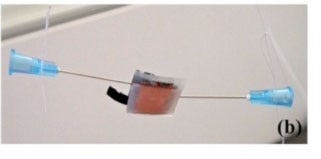Drool, Baby, Drool! Saliva May Power Oral Devices
April 21, 2014
|
A saliva-powered fuel cell. (Courtey Penn State University) |
While (so far) it produces less than one microwatt of power, researchers have figured out how to harvest electricity from human saliva.
Using the oxygen in the air as the cathode and graphene as the anode, scientists at the King Abdullah University of Science and Technology (Thuwal, Saudi Arabia) and Penn State University (State College, PA) have harnessed bacteria into a 25-?l microbial fuel cell (MFC).
Although saliva does not have the type of bacteria necessary for the fuel cells, it can be inserted in the device by a manufacturer. As the bacteria digest organic material in the saliva, they give off electrons that are deposited on the graphene anode for harvesting. The researchers said they had tried using a carbon cloth anode, but found that graphene was 40 times more efficient.
Refresh your medical device industry knowledge at MD&M East, June 9-12, 2014 in New York City. |
Bruce Logan, PhD, Evan Pugh Professor and Kappe Professor of Environmental Engineering at Penn State, credited the idea to researcher Justine E. Mink PhD, according to a story on the Penn State News (PSN) website. "The idea was Justine's because she was thinking about sensors for such things as glucose monitoring for diabetics and she wondered if a mini microbial fuel cell could be used," Logan said.
Logan told PSN reporter A'ndrea Elyse Messer that air cathodes have not previously been tried because if oxygen can get to the bacteria, they will use the oxygen and do not produce electricity.
"We have previously avoided using air cathodes in these systems to avoid oxygen contamination with closely spaced electrodes," said Logan. "However, these micro cells operate at micron distances between the electrodes. We don't fully understand why, but bottom line, they worked."
The research, "Energy Harvesting from Organic Liquids in Micro-Sized Microbial Fuel Cells," was published in Nature's NPG Asia Materials journal. The scientists posit that one potential use for their power source might be as a fertility signaling device, small enough to be attached to a tooth, that could predict a woman's ovulation from changes in her saliva's electrical conductivity, which is known to plummet five days before ovulation.
Stephen Levy is a contributor to Qmed and MPMN.
About the Author(s)
You May Also Like



.png?width=300&auto=webp&quality=80&disable=upscale)